Decision Making Application
VerifiedAdded on 2023/04/20
|15
|4151
|435
AI Summary
This document explores the concept of decision making and its application in organizations. It discusses the impact of biasness on decision making and strategies to address bias. The document also provides relevant scenarios and examples to illustrate these concepts.
Contribute Materials
Your contribution can guide someone’s learning journey. Share your
documents today.
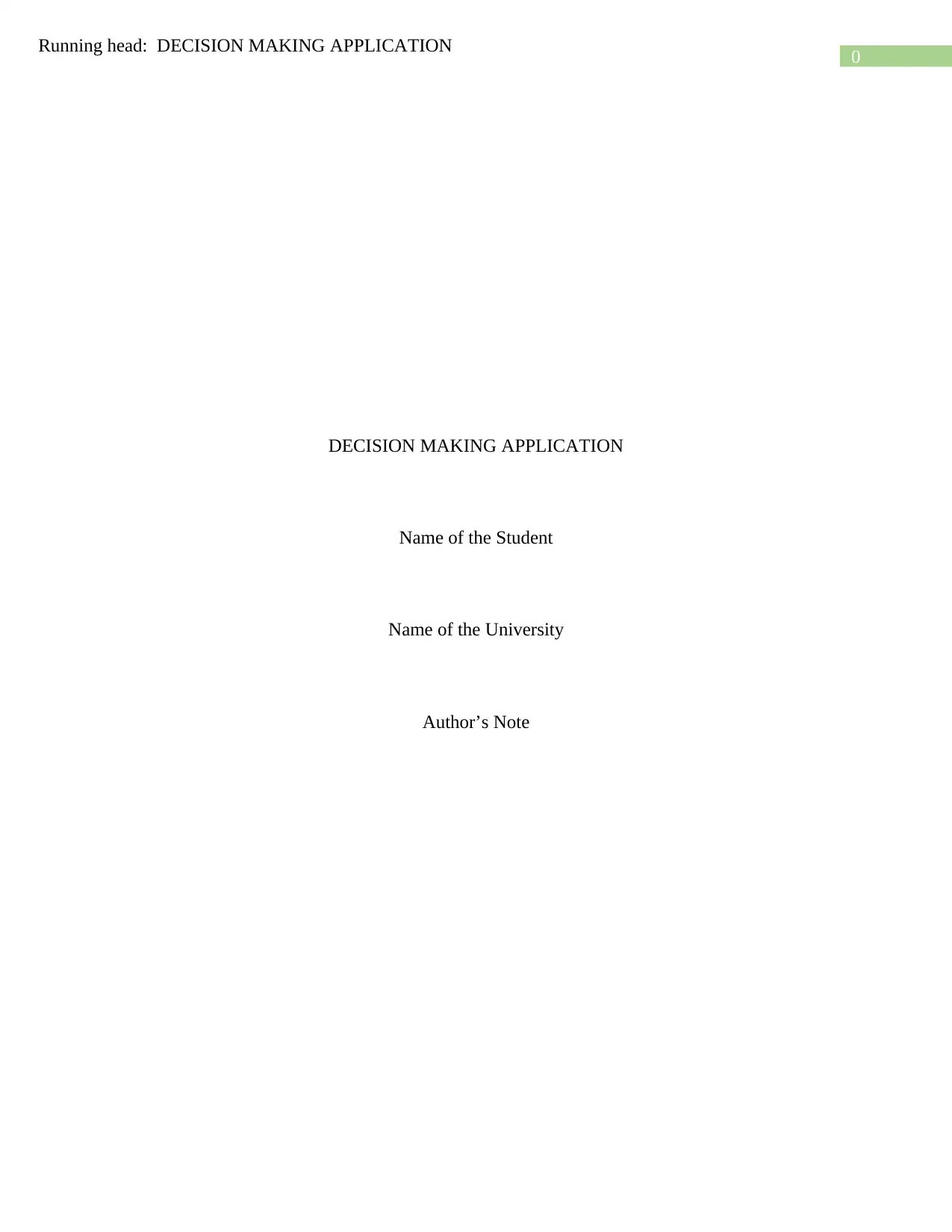
0
Running head: DECISION MAKING APPLICATION
DECISION MAKING APPLICATION
Name of the Student
Name of the University
Author’s Note
Running head: DECISION MAKING APPLICATION
DECISION MAKING APPLICATION
Name of the Student
Name of the University
Author’s Note
Secure Best Marks with AI Grader
Need help grading? Try our AI Grader for instant feedback on your assignments.
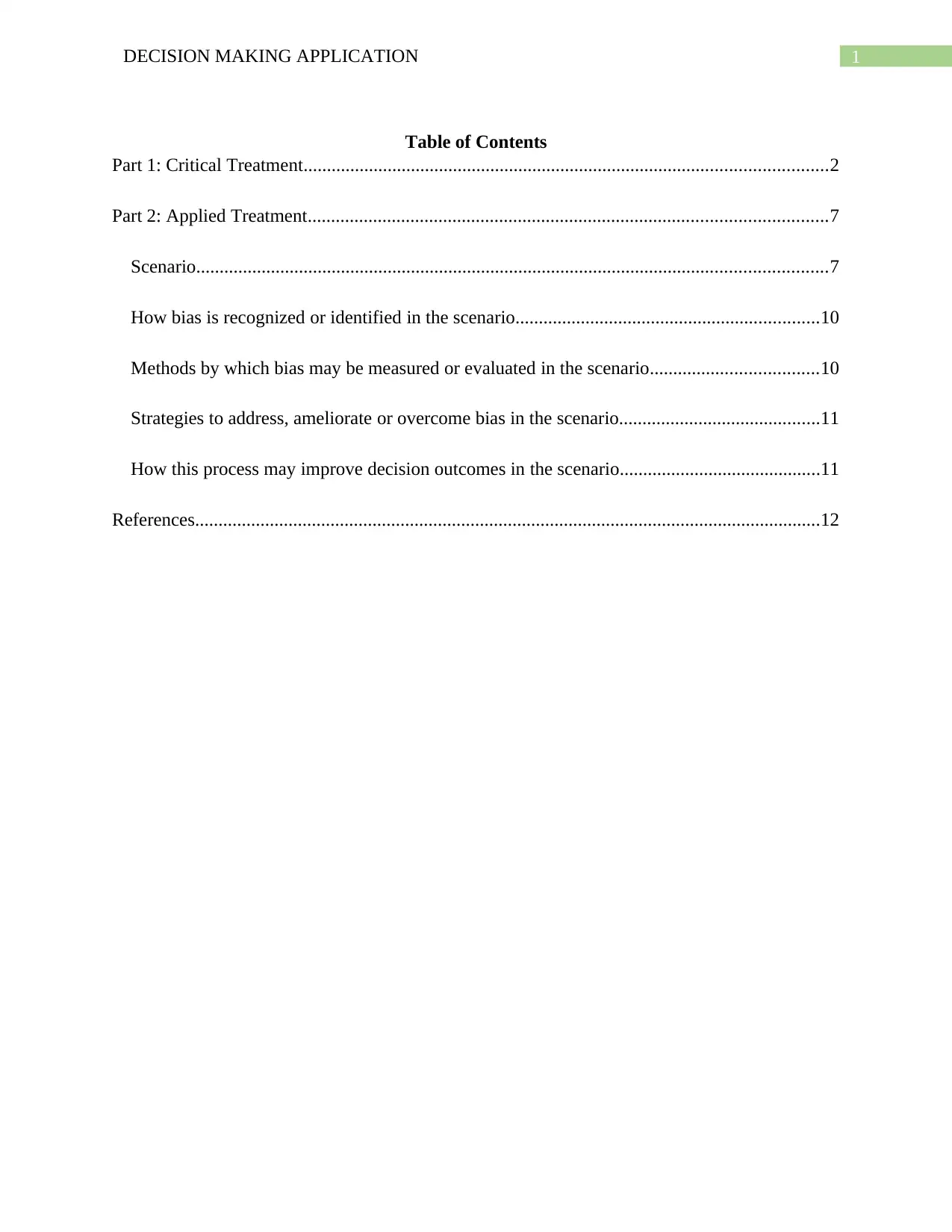
1DECISION MAKING APPLICATION
Table of Contents
Part 1: Critical Treatment................................................................................................................2
Part 2: Applied Treatment...............................................................................................................7
Scenario.......................................................................................................................................7
How bias is recognized or identified in the scenario.................................................................10
Methods by which bias may be measured or evaluated in the scenario....................................10
Strategies to address, ameliorate or overcome bias in the scenario...........................................11
How this process may improve decision outcomes in the scenario...........................................11
References......................................................................................................................................12
Table of Contents
Part 1: Critical Treatment................................................................................................................2
Part 2: Applied Treatment...............................................................................................................7
Scenario.......................................................................................................................................7
How bias is recognized or identified in the scenario.................................................................10
Methods by which bias may be measured or evaluated in the scenario....................................10
Strategies to address, ameliorate or overcome bias in the scenario...........................................11
How this process may improve decision outcomes in the scenario...........................................11
References......................................................................................................................................12
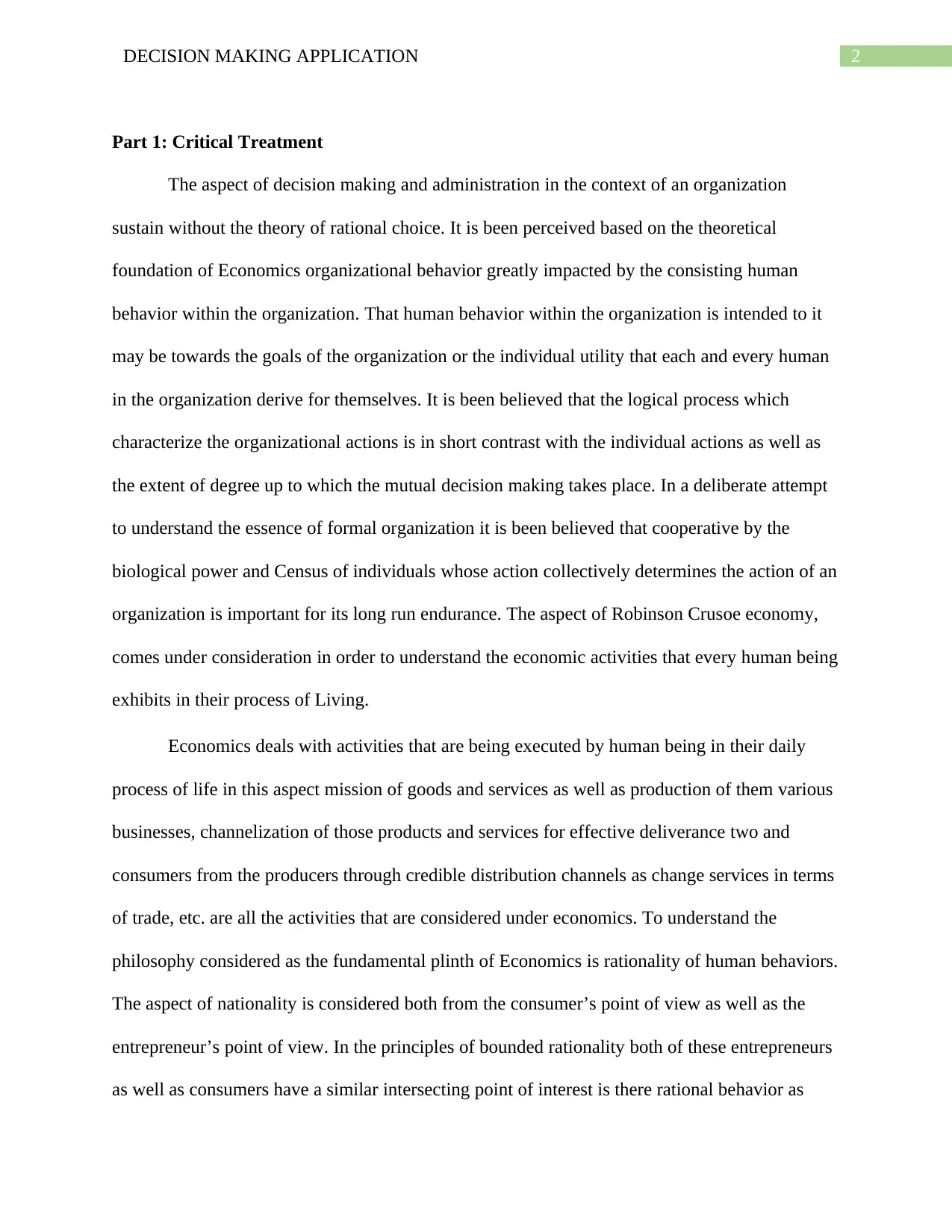
2DECISION MAKING APPLICATION
Part 1: Critical Treatment
The aspect of decision making and administration in the context of an organization
sustain without the theory of rational choice. It is been perceived based on the theoretical
foundation of Economics organizational behavior greatly impacted by the consisting human
behavior within the organization. That human behavior within the organization is intended to it
may be towards the goals of the organization or the individual utility that each and every human
in the organization derive for themselves. It is been believed that the logical process which
characterize the organizational actions is in short contrast with the individual actions as well as
the extent of degree up to which the mutual decision making takes place. In a deliberate attempt
to understand the essence of formal organization it is been believed that cooperative by the
biological power and Census of individuals whose action collectively determines the action of an
organization is important for its long run endurance. The aspect of Robinson Crusoe economy,
comes under consideration in order to understand the economic activities that every human being
exhibits in their process of Living.
Economics deals with activities that are being executed by human being in their daily
process of life in this aspect mission of goods and services as well as production of them various
businesses, channelization of those products and services for effective deliverance two and
consumers from the producers through credible distribution channels as change services in terms
of trade, etc. are all the activities that are considered under economics. To understand the
philosophy considered as the fundamental plinth of Economics is rationality of human behaviors.
The aspect of nationality is considered both from the consumer’s point of view as well as the
entrepreneur’s point of view. In the principles of bounded rationality both of these entrepreneurs
as well as consumers have a similar intersecting point of interest is there rational behavior as
Part 1: Critical Treatment
The aspect of decision making and administration in the context of an organization
sustain without the theory of rational choice. It is been perceived based on the theoretical
foundation of Economics organizational behavior greatly impacted by the consisting human
behavior within the organization. That human behavior within the organization is intended to it
may be towards the goals of the organization or the individual utility that each and every human
in the organization derive for themselves. It is been believed that the logical process which
characterize the organizational actions is in short contrast with the individual actions as well as
the extent of degree up to which the mutual decision making takes place. In a deliberate attempt
to understand the essence of formal organization it is been believed that cooperative by the
biological power and Census of individuals whose action collectively determines the action of an
organization is important for its long run endurance. The aspect of Robinson Crusoe economy,
comes under consideration in order to understand the economic activities that every human being
exhibits in their process of Living.
Economics deals with activities that are being executed by human being in their daily
process of life in this aspect mission of goods and services as well as production of them various
businesses, channelization of those products and services for effective deliverance two and
consumers from the producers through credible distribution channels as change services in terms
of trade, etc. are all the activities that are considered under economics. To understand the
philosophy considered as the fundamental plinth of Economics is rationality of human behaviors.
The aspect of nationality is considered both from the consumer’s point of view as well as the
entrepreneur’s point of view. In the principles of bounded rationality both of these entrepreneurs
as well as consumers have a similar intersecting point of interest is there rational behavior as
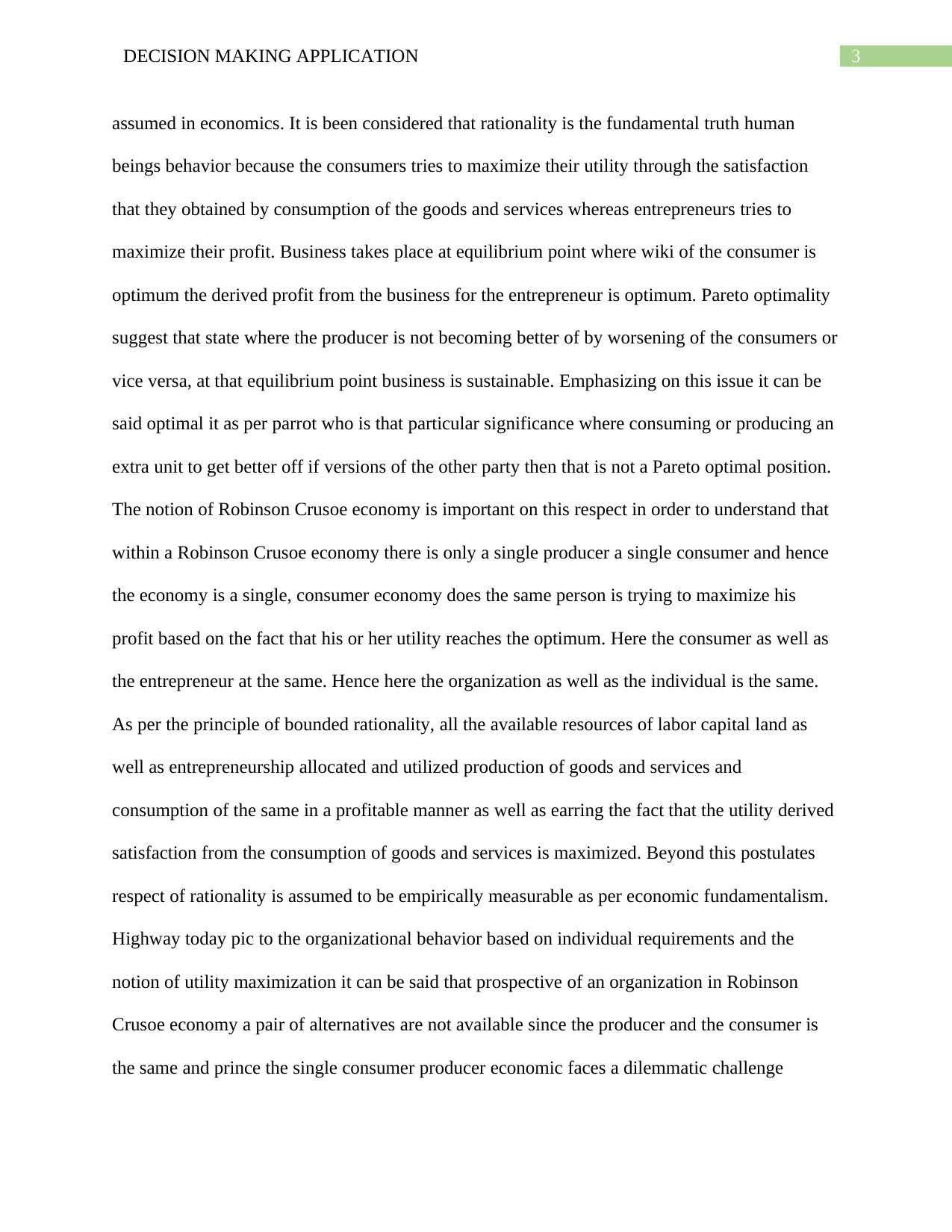
3DECISION MAKING APPLICATION
assumed in economics. It is been considered that rationality is the fundamental truth human
beings behavior because the consumers tries to maximize their utility through the satisfaction
that they obtained by consumption of the goods and services whereas entrepreneurs tries to
maximize their profit. Business takes place at equilibrium point where wiki of the consumer is
optimum the derived profit from the business for the entrepreneur is optimum. Pareto optimality
suggest that state where the producer is not becoming better of by worsening of the consumers or
vice versa, at that equilibrium point business is sustainable. Emphasizing on this issue it can be
said optimal it as per parrot who is that particular significance where consuming or producing an
extra unit to get better off if versions of the other party then that is not a Pareto optimal position.
The notion of Robinson Crusoe economy is important on this respect in order to understand that
within a Robinson Crusoe economy there is only a single producer a single consumer and hence
the economy is a single, consumer economy does the same person is trying to maximize his
profit based on the fact that his or her utility reaches the optimum. Here the consumer as well as
the entrepreneur at the same. Hence here the organization as well as the individual is the same.
As per the principle of bounded rationality, all the available resources of labor capital land as
well as entrepreneurship allocated and utilized production of goods and services and
consumption of the same in a profitable manner as well as earring the fact that the utility derived
satisfaction from the consumption of goods and services is maximized. Beyond this postulates
respect of rationality is assumed to be empirically measurable as per economic fundamentalism.
Highway today pic to the organizational behavior based on individual requirements and the
notion of utility maximization it can be said that prospective of an organization in Robinson
Crusoe economy a pair of alternatives are not available since the producer and the consumer is
the same and prince the single consumer producer economic faces a dilemmatic challenge
assumed in economics. It is been considered that rationality is the fundamental truth human
beings behavior because the consumers tries to maximize their utility through the satisfaction
that they obtained by consumption of the goods and services whereas entrepreneurs tries to
maximize their profit. Business takes place at equilibrium point where wiki of the consumer is
optimum the derived profit from the business for the entrepreneur is optimum. Pareto optimality
suggest that state where the producer is not becoming better of by worsening of the consumers or
vice versa, at that equilibrium point business is sustainable. Emphasizing on this issue it can be
said optimal it as per parrot who is that particular significance where consuming or producing an
extra unit to get better off if versions of the other party then that is not a Pareto optimal position.
The notion of Robinson Crusoe economy is important on this respect in order to understand that
within a Robinson Crusoe economy there is only a single producer a single consumer and hence
the economy is a single, consumer economy does the same person is trying to maximize his
profit based on the fact that his or her utility reaches the optimum. Here the consumer as well as
the entrepreneur at the same. Hence here the organization as well as the individual is the same.
As per the principle of bounded rationality, all the available resources of labor capital land as
well as entrepreneurship allocated and utilized production of goods and services and
consumption of the same in a profitable manner as well as earring the fact that the utility derived
satisfaction from the consumption of goods and services is maximized. Beyond this postulates
respect of rationality is assumed to be empirically measurable as per economic fundamentalism.
Highway today pic to the organizational behavior based on individual requirements and the
notion of utility maximization it can be said that prospective of an organization in Robinson
Crusoe economy a pair of alternatives are not available since the producer and the consumer is
the same and prince the single consumer producer economic faces a dilemmatic challenge
Secure Best Marks with AI Grader
Need help grading? Try our AI Grader for instant feedback on your assignments.
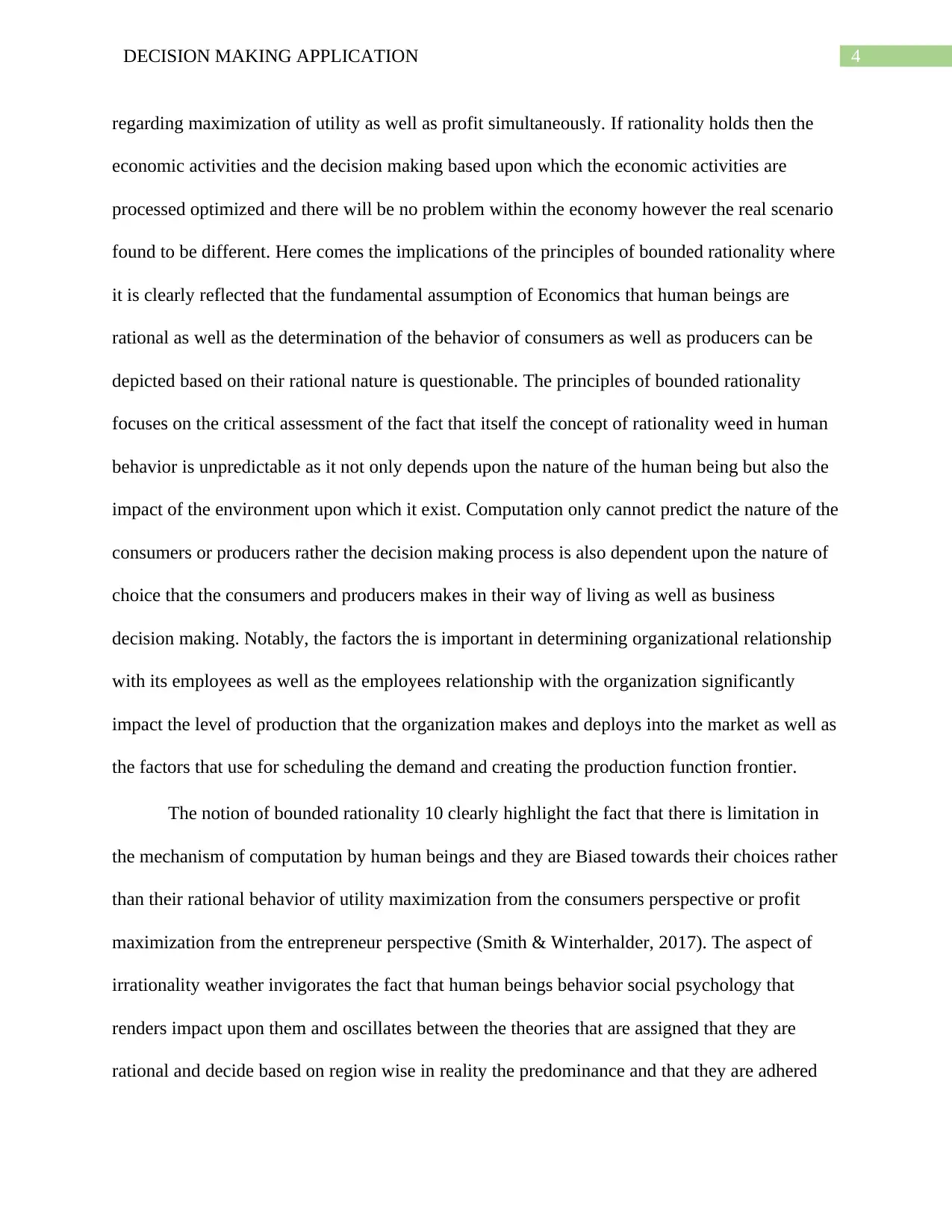
4DECISION MAKING APPLICATION
regarding maximization of utility as well as profit simultaneously. If rationality holds then the
economic activities and the decision making based upon which the economic activities are
processed optimized and there will be no problem within the economy however the real scenario
found to be different. Here comes the implications of the principles of bounded rationality where
it is clearly reflected that the fundamental assumption of Economics that human beings are
rational as well as the determination of the behavior of consumers as well as producers can be
depicted based on their rational nature is questionable. The principles of bounded rationality
focuses on the critical assessment of the fact that itself the concept of rationality weed in human
behavior is unpredictable as it not only depends upon the nature of the human being but also the
impact of the environment upon which it exist. Computation only cannot predict the nature of the
consumers or producers rather the decision making process is also dependent upon the nature of
choice that the consumers and producers makes in their way of living as well as business
decision making. Notably, the factors the is important in determining organizational relationship
with its employees as well as the employees relationship with the organization significantly
impact the level of production that the organization makes and deploys into the market as well as
the factors that use for scheduling the demand and creating the production function frontier.
The notion of bounded rationality 10 clearly highlight the fact that there is limitation in
the mechanism of computation by human beings and they are Biased towards their choices rather
than their rational behavior of utility maximization from the consumers perspective or profit
maximization from the entrepreneur perspective (Smith & Winterhalder, 2017). The aspect of
irrationality weather invigorates the fact that human beings behavior social psychology that
renders impact upon them and oscillates between the theories that are assigned that they are
rational and decide based on region wise in reality the predominance and that they are adhered
regarding maximization of utility as well as profit simultaneously. If rationality holds then the
economic activities and the decision making based upon which the economic activities are
processed optimized and there will be no problem within the economy however the real scenario
found to be different. Here comes the implications of the principles of bounded rationality where
it is clearly reflected that the fundamental assumption of Economics that human beings are
rational as well as the determination of the behavior of consumers as well as producers can be
depicted based on their rational nature is questionable. The principles of bounded rationality
focuses on the critical assessment of the fact that itself the concept of rationality weed in human
behavior is unpredictable as it not only depends upon the nature of the human being but also the
impact of the environment upon which it exist. Computation only cannot predict the nature of the
consumers or producers rather the decision making process is also dependent upon the nature of
choice that the consumers and producers makes in their way of living as well as business
decision making. Notably, the factors the is important in determining organizational relationship
with its employees as well as the employees relationship with the organization significantly
impact the level of production that the organization makes and deploys into the market as well as
the factors that use for scheduling the demand and creating the production function frontier.
The notion of bounded rationality 10 clearly highlight the fact that there is limitation in
the mechanism of computation by human beings and they are Biased towards their choices rather
than their rational behavior of utility maximization from the consumers perspective or profit
maximization from the entrepreneur perspective (Smith & Winterhalder, 2017). The aspect of
irrationality weather invigorates the fact that human beings behavior social psychology that
renders impact upon them and oscillates between the theories that are assigned that they are
rational and decide based on region wise in reality the predominance and that they are adhered
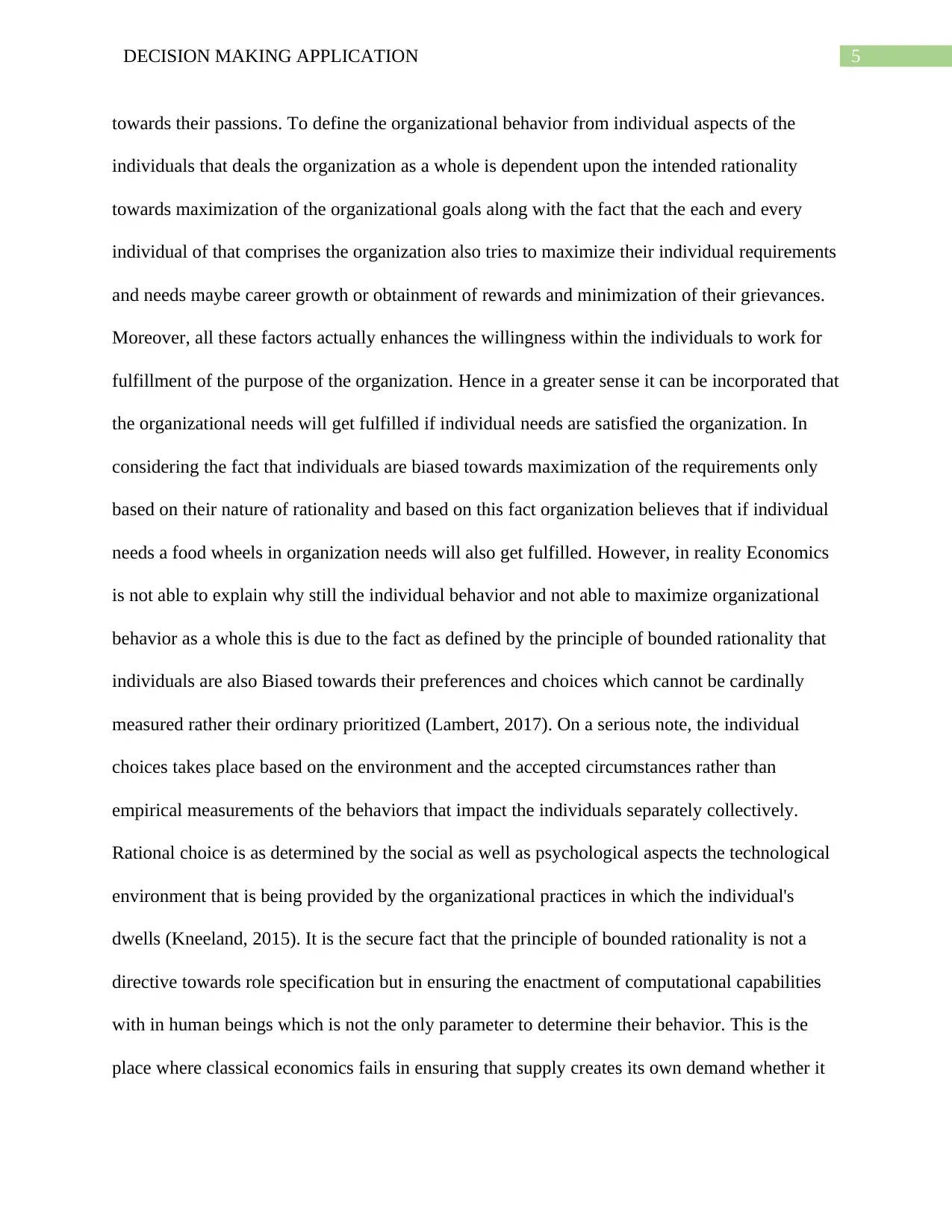
5DECISION MAKING APPLICATION
towards their passions. To define the organizational behavior from individual aspects of the
individuals that deals the organization as a whole is dependent upon the intended rationality
towards maximization of the organizational goals along with the fact that the each and every
individual of that comprises the organization also tries to maximize their individual requirements
and needs maybe career growth or obtainment of rewards and minimization of their grievances.
Moreover, all these factors actually enhances the willingness within the individuals to work for
fulfillment of the purpose of the organization. Hence in a greater sense it can be incorporated that
the organizational needs will get fulfilled if individual needs are satisfied the organization. In
considering the fact that individuals are biased towards maximization of the requirements only
based on their nature of rationality and based on this fact organization believes that if individual
needs a food wheels in organization needs will also get fulfilled. However, in reality Economics
is not able to explain why still the individual behavior and not able to maximize organizational
behavior as a whole this is due to the fact as defined by the principle of bounded rationality that
individuals are also Biased towards their preferences and choices which cannot be cardinally
measured rather their ordinary prioritized (Lambert, 2017). On a serious note, the individual
choices takes place based on the environment and the accepted circumstances rather than
empirical measurements of the behaviors that impact the individuals separately collectively.
Rational choice is as determined by the social as well as psychological aspects the technological
environment that is being provided by the organizational practices in which the individual's
dwells (Kneeland, 2015). It is the secure fact that the principle of bounded rationality is not a
directive towards role specification but in ensuring the enactment of computational capabilities
with in human beings which is not the only parameter to determine their behavior. This is the
place where classical economics fails in ensuring that supply creates its own demand whether it
towards their passions. To define the organizational behavior from individual aspects of the
individuals that deals the organization as a whole is dependent upon the intended rationality
towards maximization of the organizational goals along with the fact that the each and every
individual of that comprises the organization also tries to maximize their individual requirements
and needs maybe career growth or obtainment of rewards and minimization of their grievances.
Moreover, all these factors actually enhances the willingness within the individuals to work for
fulfillment of the purpose of the organization. Hence in a greater sense it can be incorporated that
the organizational needs will get fulfilled if individual needs are satisfied the organization. In
considering the fact that individuals are biased towards maximization of the requirements only
based on their nature of rationality and based on this fact organization believes that if individual
needs a food wheels in organization needs will also get fulfilled. However, in reality Economics
is not able to explain why still the individual behavior and not able to maximize organizational
behavior as a whole this is due to the fact as defined by the principle of bounded rationality that
individuals are also Biased towards their preferences and choices which cannot be cardinally
measured rather their ordinary prioritized (Lambert, 2017). On a serious note, the individual
choices takes place based on the environment and the accepted circumstances rather than
empirical measurements of the behaviors that impact the individuals separately collectively.
Rational choice is as determined by the social as well as psychological aspects the technological
environment that is being provided by the organizational practices in which the individual's
dwells (Kneeland, 2015). It is the secure fact that the principle of bounded rationality is not a
directive towards role specification but in ensuring the enactment of computational capabilities
with in human beings which is not the only parameter to determine their behavior. This is the
place where classical economics fails in ensuring that supply creates its own demand whether it
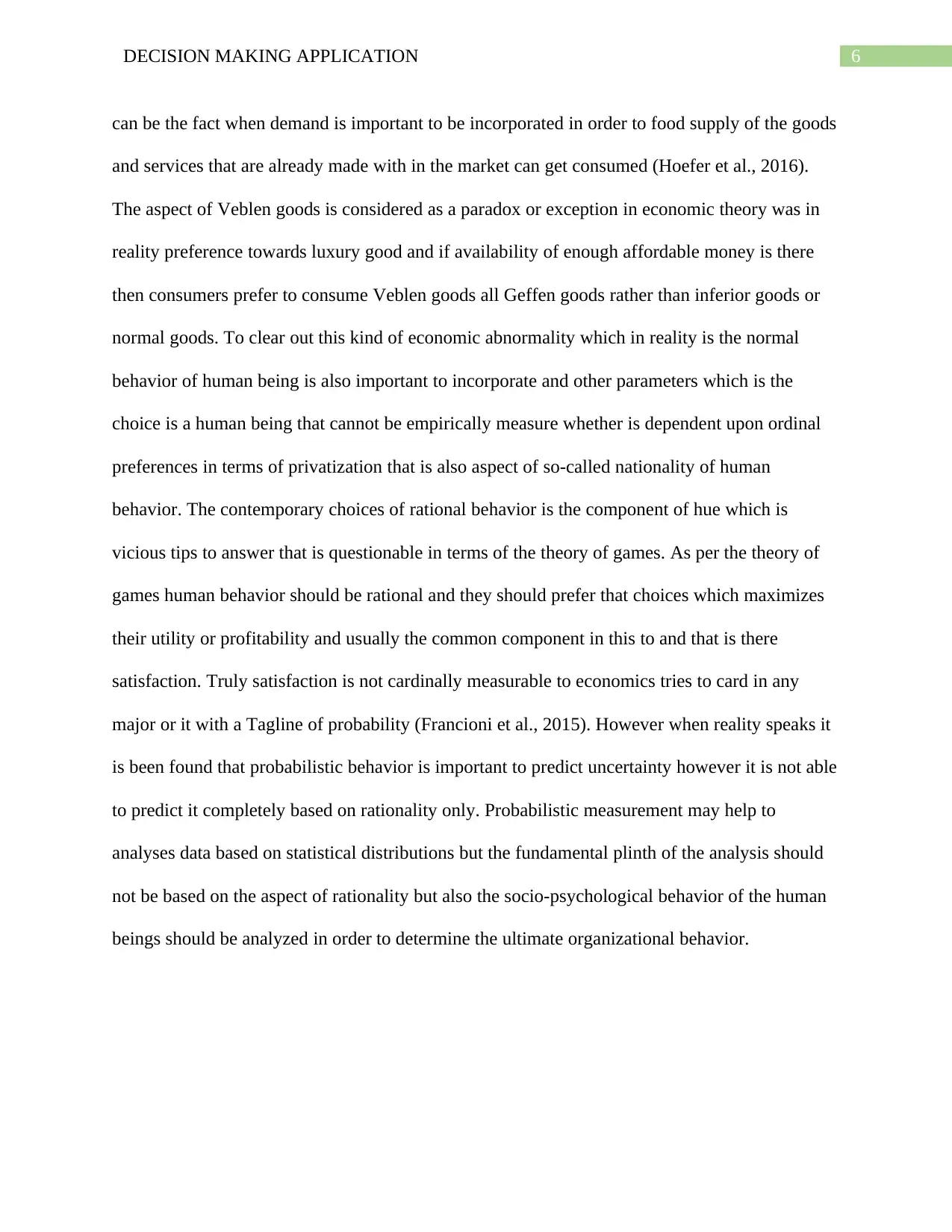
6DECISION MAKING APPLICATION
can be the fact when demand is important to be incorporated in order to food supply of the goods
and services that are already made with in the market can get consumed (Hoefer et al., 2016).
The aspect of Veblen goods is considered as a paradox or exception in economic theory was in
reality preference towards luxury good and if availability of enough affordable money is there
then consumers prefer to consume Veblen goods all Geffen goods rather than inferior goods or
normal goods. To clear out this kind of economic abnormality which in reality is the normal
behavior of human being is also important to incorporate and other parameters which is the
choice is a human being that cannot be empirically measure whether is dependent upon ordinal
preferences in terms of privatization that is also aspect of so-called nationality of human
behavior. The contemporary choices of rational behavior is the component of hue which is
vicious tips to answer that is questionable in terms of the theory of games. As per the theory of
games human behavior should be rational and they should prefer that choices which maximizes
their utility or profitability and usually the common component in this to and that is there
satisfaction. Truly satisfaction is not cardinally measurable to economics tries to card in any
major or it with a Tagline of probability (Francioni et al., 2015). However when reality speaks it
is been found that probabilistic behavior is important to predict uncertainty however it is not able
to predict it completely based on rationality only. Probabilistic measurement may help to
analyses data based on statistical distributions but the fundamental plinth of the analysis should
not be based on the aspect of rationality but also the socio-psychological behavior of the human
beings should be analyzed in order to determine the ultimate organizational behavior.
can be the fact when demand is important to be incorporated in order to food supply of the goods
and services that are already made with in the market can get consumed (Hoefer et al., 2016).
The aspect of Veblen goods is considered as a paradox or exception in economic theory was in
reality preference towards luxury good and if availability of enough affordable money is there
then consumers prefer to consume Veblen goods all Geffen goods rather than inferior goods or
normal goods. To clear out this kind of economic abnormality which in reality is the normal
behavior of human being is also important to incorporate and other parameters which is the
choice is a human being that cannot be empirically measure whether is dependent upon ordinal
preferences in terms of privatization that is also aspect of so-called nationality of human
behavior. The contemporary choices of rational behavior is the component of hue which is
vicious tips to answer that is questionable in terms of the theory of games. As per the theory of
games human behavior should be rational and they should prefer that choices which maximizes
their utility or profitability and usually the common component in this to and that is there
satisfaction. Truly satisfaction is not cardinally measurable to economics tries to card in any
major or it with a Tagline of probability (Francioni et al., 2015). However when reality speaks it
is been found that probabilistic behavior is important to predict uncertainty however it is not able
to predict it completely based on rationality only. Probabilistic measurement may help to
analyses data based on statistical distributions but the fundamental plinth of the analysis should
not be based on the aspect of rationality but also the socio-psychological behavior of the human
beings should be analyzed in order to determine the ultimate organizational behavior.
Paraphrase This Document
Need a fresh take? Get an instant paraphrase of this document with our AI Paraphraser
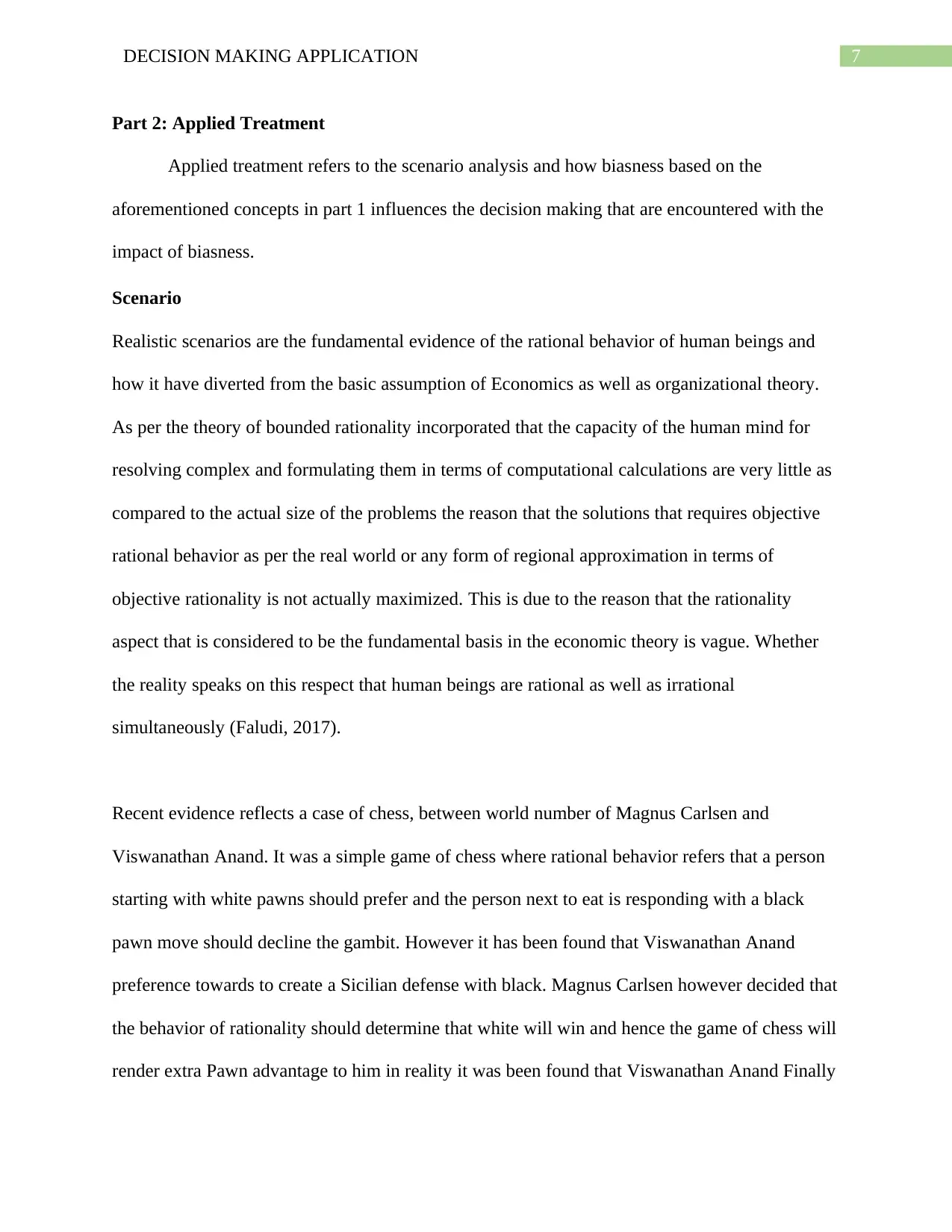
7DECISION MAKING APPLICATION
Part 2: Applied Treatment
Applied treatment refers to the scenario analysis and how biasness based on the
aforementioned concepts in part 1 influences the decision making that are encountered with the
impact of biasness.
Scenario
Realistic scenarios are the fundamental evidence of the rational behavior of human beings and
how it have diverted from the basic assumption of Economics as well as organizational theory.
As per the theory of bounded rationality incorporated that the capacity of the human mind for
resolving complex and formulating them in terms of computational calculations are very little as
compared to the actual size of the problems the reason that the solutions that requires objective
rational behavior as per the real world or any form of regional approximation in terms of
objective rationality is not actually maximized. This is due to the reason that the rationality
aspect that is considered to be the fundamental basis in the economic theory is vague. Whether
the reality speaks on this respect that human beings are rational as well as irrational
simultaneously (Faludi, 2017).
Recent evidence reflects a case of chess, between world number of Magnus Carlsen and
Viswanathan Anand. It was a simple game of chess where rational behavior refers that a person
starting with white pawns should prefer and the person next to eat is responding with a black
pawn move should decline the gambit. However it has been found that Viswanathan Anand
preference towards to create a Sicilian defense with black. Magnus Carlsen however decided that
the behavior of rationality should determine that white will win and hence the game of chess will
render extra Pawn advantage to him in reality it was been found that Viswanathan Anand Finally
Part 2: Applied Treatment
Applied treatment refers to the scenario analysis and how biasness based on the
aforementioned concepts in part 1 influences the decision making that are encountered with the
impact of biasness.
Scenario
Realistic scenarios are the fundamental evidence of the rational behavior of human beings and
how it have diverted from the basic assumption of Economics as well as organizational theory.
As per the theory of bounded rationality incorporated that the capacity of the human mind for
resolving complex and formulating them in terms of computational calculations are very little as
compared to the actual size of the problems the reason that the solutions that requires objective
rational behavior as per the real world or any form of regional approximation in terms of
objective rationality is not actually maximized. This is due to the reason that the rationality
aspect that is considered to be the fundamental basis in the economic theory is vague. Whether
the reality speaks on this respect that human beings are rational as well as irrational
simultaneously (Faludi, 2017).
Recent evidence reflects a case of chess, between world number of Magnus Carlsen and
Viswanathan Anand. It was a simple game of chess where rational behavior refers that a person
starting with white pawns should prefer and the person next to eat is responding with a black
pawn move should decline the gambit. However it has been found that Viswanathan Anand
preference towards to create a Sicilian defense with black. Magnus Carlsen however decided that
the behavior of rationality should determine that white will win and hence the game of chess will
render extra Pawn advantage to him in reality it was been found that Viswanathan Anand Finally
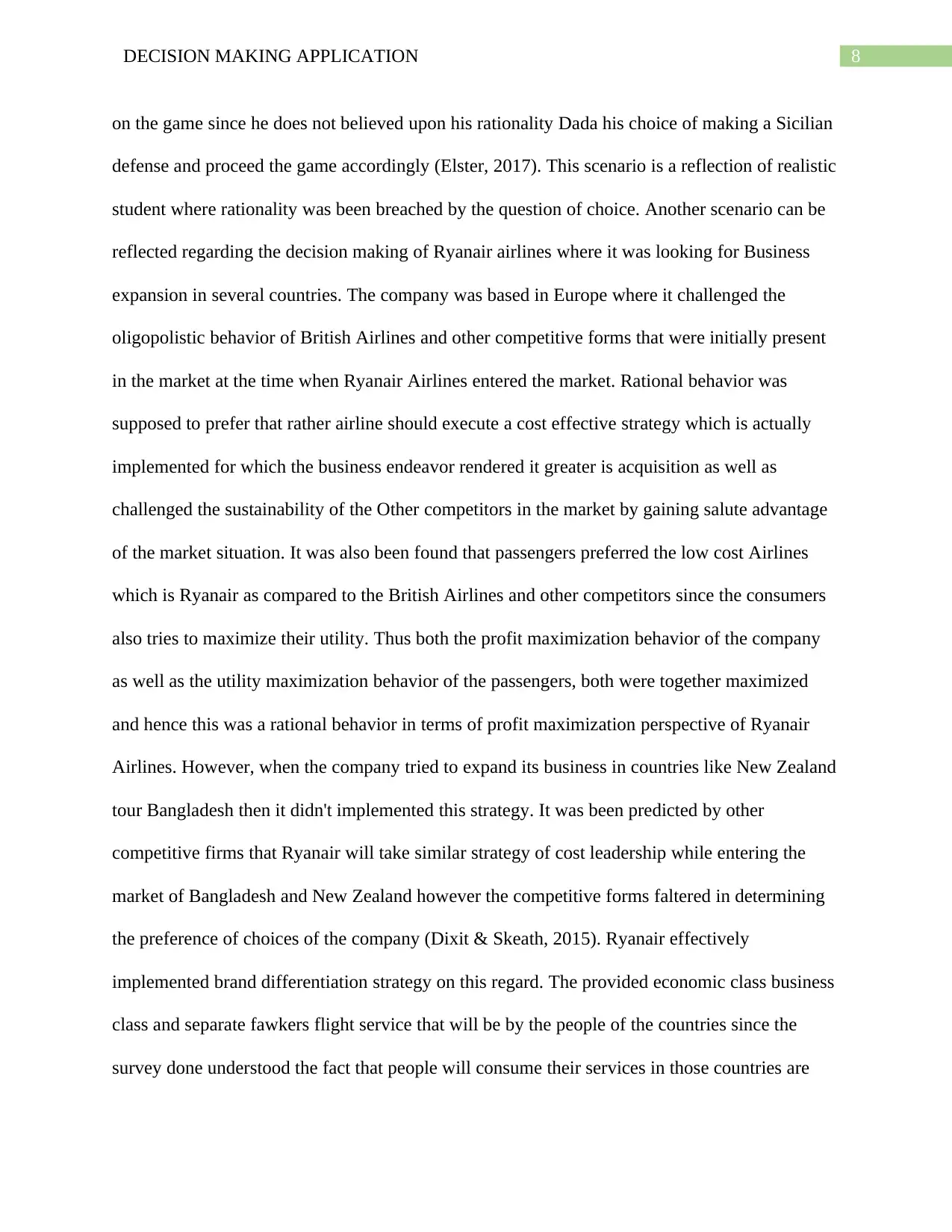
8DECISION MAKING APPLICATION
on the game since he does not believed upon his rationality Dada his choice of making a Sicilian
defense and proceed the game accordingly (Elster, 2017). This scenario is a reflection of realistic
student where rationality was been breached by the question of choice. Another scenario can be
reflected regarding the decision making of Ryanair airlines where it was looking for Business
expansion in several countries. The company was based in Europe where it challenged the
oligopolistic behavior of British Airlines and other competitive forms that were initially present
in the market at the time when Ryanair Airlines entered the market. Rational behavior was
supposed to prefer that rather airline should execute a cost effective strategy which is actually
implemented for which the business endeavor rendered it greater is acquisition as well as
challenged the sustainability of the Other competitors in the market by gaining salute advantage
of the market situation. It was also been found that passengers preferred the low cost Airlines
which is Ryanair as compared to the British Airlines and other competitors since the consumers
also tries to maximize their utility. Thus both the profit maximization behavior of the company
as well as the utility maximization behavior of the passengers, both were together maximized
and hence this was a rational behavior in terms of profit maximization perspective of Ryanair
Airlines. However, when the company tried to expand its business in countries like New Zealand
tour Bangladesh then it didn't implemented this strategy. It was been predicted by other
competitive firms that Ryanair will take similar strategy of cost leadership while entering the
market of Bangladesh and New Zealand however the competitive forms faltered in determining
the preference of choices of the company (Dixit & Skeath, 2015). Ryanair effectively
implemented brand differentiation strategy on this regard. The provided economic class business
class and separate fawkers flight service that will be by the people of the countries since the
survey done understood the fact that people will consume their services in those countries are
on the game since he does not believed upon his rationality Dada his choice of making a Sicilian
defense and proceed the game accordingly (Elster, 2017). This scenario is a reflection of realistic
student where rationality was been breached by the question of choice. Another scenario can be
reflected regarding the decision making of Ryanair airlines where it was looking for Business
expansion in several countries. The company was based in Europe where it challenged the
oligopolistic behavior of British Airlines and other competitive forms that were initially present
in the market at the time when Ryanair Airlines entered the market. Rational behavior was
supposed to prefer that rather airline should execute a cost effective strategy which is actually
implemented for which the business endeavor rendered it greater is acquisition as well as
challenged the sustainability of the Other competitors in the market by gaining salute advantage
of the market situation. It was also been found that passengers preferred the low cost Airlines
which is Ryanair as compared to the British Airlines and other competitors since the consumers
also tries to maximize their utility. Thus both the profit maximization behavior of the company
as well as the utility maximization behavior of the passengers, both were together maximized
and hence this was a rational behavior in terms of profit maximization perspective of Ryanair
Airlines. However, when the company tried to expand its business in countries like New Zealand
tour Bangladesh then it didn't implemented this strategy. It was been predicted by other
competitive firms that Ryanair will take similar strategy of cost leadership while entering the
market of Bangladesh and New Zealand however the competitive forms faltered in determining
the preference of choices of the company (Dixit & Skeath, 2015). Ryanair effectively
implemented brand differentiation strategy on this regard. The provided economic class business
class and separate fawkers flight service that will be by the people of the countries since the
survey done understood the fact that people will consume their services in those countries are
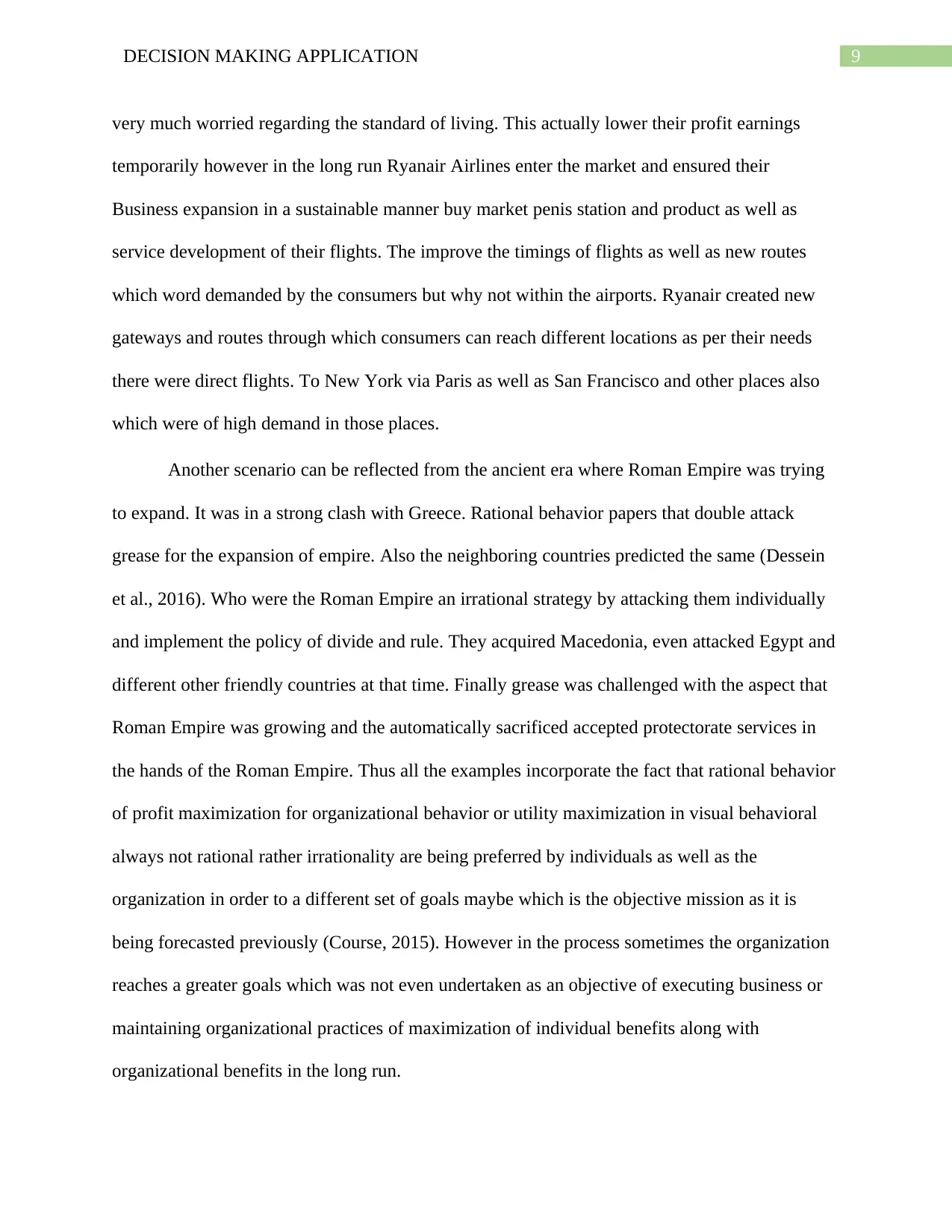
9DECISION MAKING APPLICATION
very much worried regarding the standard of living. This actually lower their profit earnings
temporarily however in the long run Ryanair Airlines enter the market and ensured their
Business expansion in a sustainable manner buy market penis station and product as well as
service development of their flights. The improve the timings of flights as well as new routes
which word demanded by the consumers but why not within the airports. Ryanair created new
gateways and routes through which consumers can reach different locations as per their needs
there were direct flights. To New York via Paris as well as San Francisco and other places also
which were of high demand in those places.
Another scenario can be reflected from the ancient era where Roman Empire was trying
to expand. It was in a strong clash with Greece. Rational behavior papers that double attack
grease for the expansion of empire. Also the neighboring countries predicted the same (Dessein
et al., 2016). Who were the Roman Empire an irrational strategy by attacking them individually
and implement the policy of divide and rule. They acquired Macedonia, even attacked Egypt and
different other friendly countries at that time. Finally grease was challenged with the aspect that
Roman Empire was growing and the automatically sacrificed accepted protectorate services in
the hands of the Roman Empire. Thus all the examples incorporate the fact that rational behavior
of profit maximization for organizational behavior or utility maximization in visual behavioral
always not rational rather irrationality are being preferred by individuals as well as the
organization in order to a different set of goals maybe which is the objective mission as it is
being forecasted previously (Course, 2015). However in the process sometimes the organization
reaches a greater goals which was not even undertaken as an objective of executing business or
maintaining organizational practices of maximization of individual benefits along with
organizational benefits in the long run.
very much worried regarding the standard of living. This actually lower their profit earnings
temporarily however in the long run Ryanair Airlines enter the market and ensured their
Business expansion in a sustainable manner buy market penis station and product as well as
service development of their flights. The improve the timings of flights as well as new routes
which word demanded by the consumers but why not within the airports. Ryanair created new
gateways and routes through which consumers can reach different locations as per their needs
there were direct flights. To New York via Paris as well as San Francisco and other places also
which were of high demand in those places.
Another scenario can be reflected from the ancient era where Roman Empire was trying
to expand. It was in a strong clash with Greece. Rational behavior papers that double attack
grease for the expansion of empire. Also the neighboring countries predicted the same (Dessein
et al., 2016). Who were the Roman Empire an irrational strategy by attacking them individually
and implement the policy of divide and rule. They acquired Macedonia, even attacked Egypt and
different other friendly countries at that time. Finally grease was challenged with the aspect that
Roman Empire was growing and the automatically sacrificed accepted protectorate services in
the hands of the Roman Empire. Thus all the examples incorporate the fact that rational behavior
of profit maximization for organizational behavior or utility maximization in visual behavioral
always not rational rather irrationality are being preferred by individuals as well as the
organization in order to a different set of goals maybe which is the objective mission as it is
being forecasted previously (Course, 2015). However in the process sometimes the organization
reaches a greater goals which was not even undertaken as an objective of executing business or
maintaining organizational practices of maximization of individual benefits along with
organizational benefits in the long run.
Secure Best Marks with AI Grader
Need help grading? Try our AI Grader for instant feedback on your assignments.
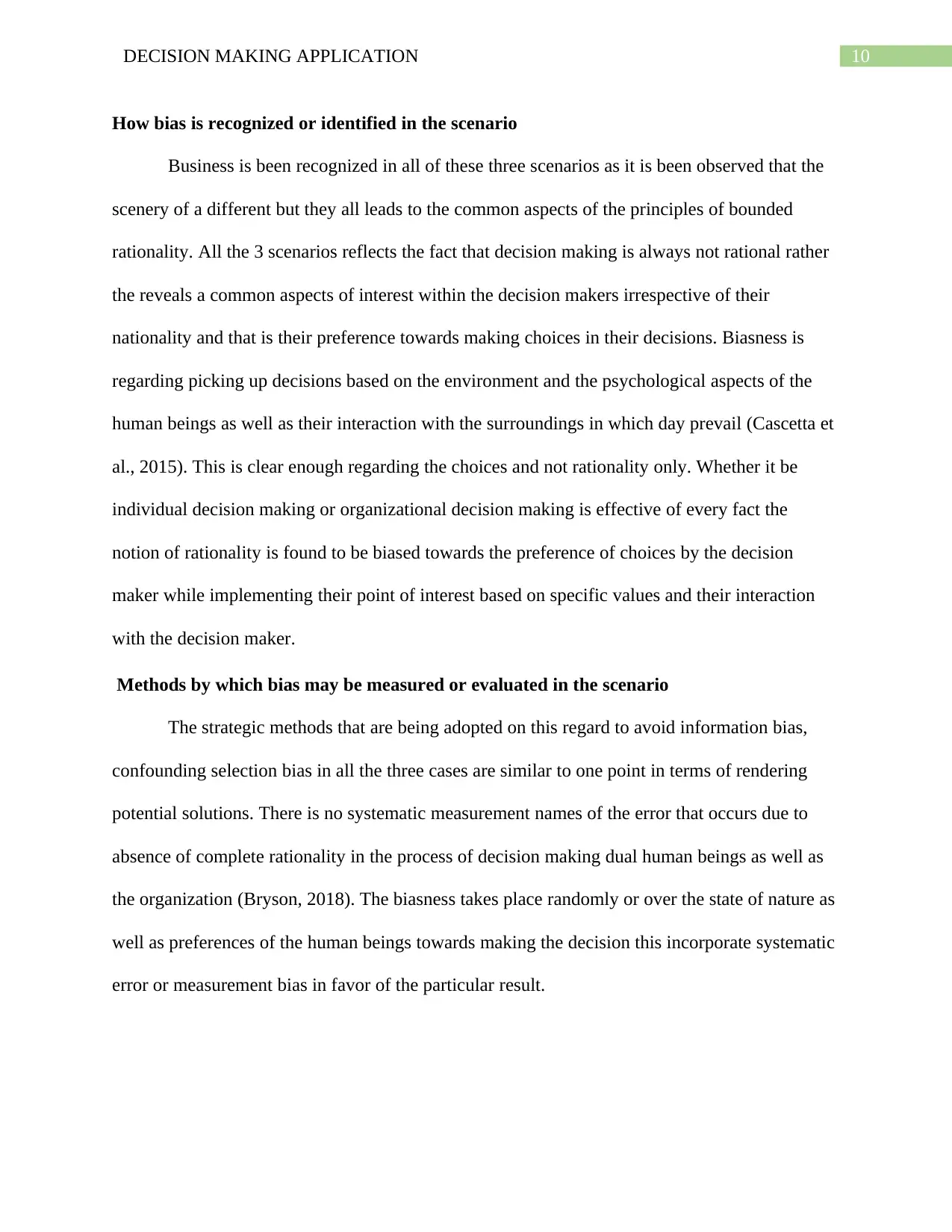
10DECISION MAKING APPLICATION
How bias is recognized or identified in the scenario
Business is been recognized in all of these three scenarios as it is been observed that the
scenery of a different but they all leads to the common aspects of the principles of bounded
rationality. All the 3 scenarios reflects the fact that decision making is always not rational rather
the reveals a common aspects of interest within the decision makers irrespective of their
nationality and that is their preference towards making choices in their decisions. Biasness is
regarding picking up decisions based on the environment and the psychological aspects of the
human beings as well as their interaction with the surroundings in which day prevail (Cascetta et
al., 2015). This is clear enough regarding the choices and not rationality only. Whether it be
individual decision making or organizational decision making is effective of every fact the
notion of rationality is found to be biased towards the preference of choices by the decision
maker while implementing their point of interest based on specific values and their interaction
with the decision maker.
Methods by which bias may be measured or evaluated in the scenario
The strategic methods that are being adopted on this regard to avoid information bias,
confounding selection bias in all the three cases are similar to one point in terms of rendering
potential solutions. There is no systematic measurement names of the error that occurs due to
absence of complete rationality in the process of decision making dual human beings as well as
the organization (Bryson, 2018). The biasness takes place randomly or over the state of nature as
well as preferences of the human beings towards making the decision this incorporate systematic
error or measurement bias in favor of the particular result.
How bias is recognized or identified in the scenario
Business is been recognized in all of these three scenarios as it is been observed that the
scenery of a different but they all leads to the common aspects of the principles of bounded
rationality. All the 3 scenarios reflects the fact that decision making is always not rational rather
the reveals a common aspects of interest within the decision makers irrespective of their
nationality and that is their preference towards making choices in their decisions. Biasness is
regarding picking up decisions based on the environment and the psychological aspects of the
human beings as well as their interaction with the surroundings in which day prevail (Cascetta et
al., 2015). This is clear enough regarding the choices and not rationality only. Whether it be
individual decision making or organizational decision making is effective of every fact the
notion of rationality is found to be biased towards the preference of choices by the decision
maker while implementing their point of interest based on specific values and their interaction
with the decision maker.
Methods by which bias may be measured or evaluated in the scenario
The strategic methods that are being adopted on this regard to avoid information bias,
confounding selection bias in all the three cases are similar to one point in terms of rendering
potential solutions. There is no systematic measurement names of the error that occurs due to
absence of complete rationality in the process of decision making dual human beings as well as
the organization (Bryson, 2018). The biasness takes place randomly or over the state of nature as
well as preferences of the human beings towards making the decision this incorporate systematic
error or measurement bias in favor of the particular result.
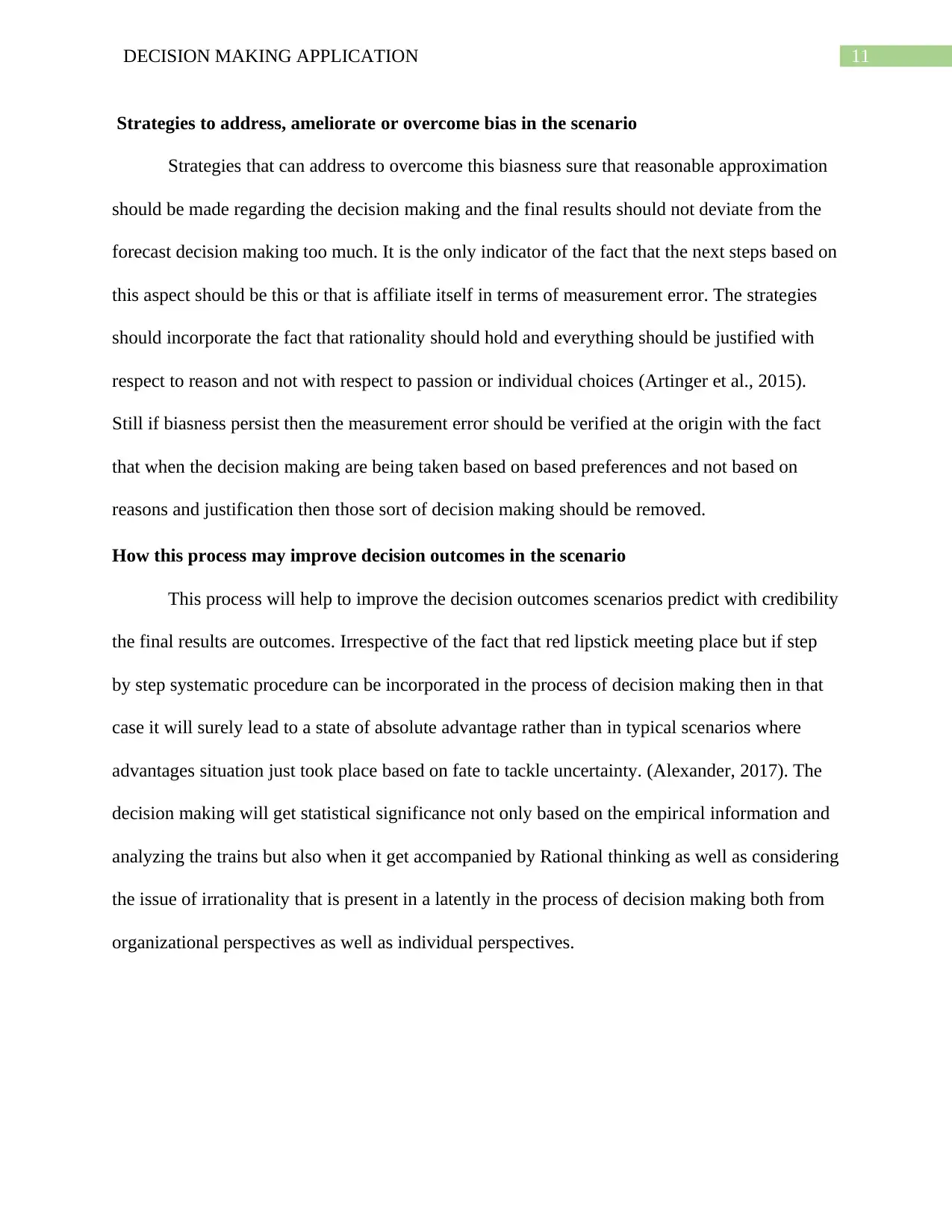
11DECISION MAKING APPLICATION
Strategies to address, ameliorate or overcome bias in the scenario
Strategies that can address to overcome this biasness sure that reasonable approximation
should be made regarding the decision making and the final results should not deviate from the
forecast decision making too much. It is the only indicator of the fact that the next steps based on
this aspect should be this or that is affiliate itself in terms of measurement error. The strategies
should incorporate the fact that rationality should hold and everything should be justified with
respect to reason and not with respect to passion or individual choices (Artinger et al., 2015).
Still if biasness persist then the measurement error should be verified at the origin with the fact
that when the decision making are being taken based on based preferences and not based on
reasons and justification then those sort of decision making should be removed.
How this process may improve decision outcomes in the scenario
This process will help to improve the decision outcomes scenarios predict with credibility
the final results are outcomes. Irrespective of the fact that red lipstick meeting place but if step
by step systematic procedure can be incorporated in the process of decision making then in that
case it will surely lead to a state of absolute advantage rather than in typical scenarios where
advantages situation just took place based on fate to tackle uncertainty. (Alexander, 2017). The
decision making will get statistical significance not only based on the empirical information and
analyzing the trains but also when it get accompanied by Rational thinking as well as considering
the issue of irrationality that is present in a latently in the process of decision making both from
organizational perspectives as well as individual perspectives.
Strategies to address, ameliorate or overcome bias in the scenario
Strategies that can address to overcome this biasness sure that reasonable approximation
should be made regarding the decision making and the final results should not deviate from the
forecast decision making too much. It is the only indicator of the fact that the next steps based on
this aspect should be this or that is affiliate itself in terms of measurement error. The strategies
should incorporate the fact that rationality should hold and everything should be justified with
respect to reason and not with respect to passion or individual choices (Artinger et al., 2015).
Still if biasness persist then the measurement error should be verified at the origin with the fact
that when the decision making are being taken based on based preferences and not based on
reasons and justification then those sort of decision making should be removed.
How this process may improve decision outcomes in the scenario
This process will help to improve the decision outcomes scenarios predict with credibility
the final results are outcomes. Irrespective of the fact that red lipstick meeting place but if step
by step systematic procedure can be incorporated in the process of decision making then in that
case it will surely lead to a state of absolute advantage rather than in typical scenarios where
advantages situation just took place based on fate to tackle uncertainty. (Alexander, 2017). The
decision making will get statistical significance not only based on the empirical information and
analyzing the trains but also when it get accompanied by Rational thinking as well as considering
the issue of irrationality that is present in a latently in the process of decision making both from
organizational perspectives as well as individual perspectives.
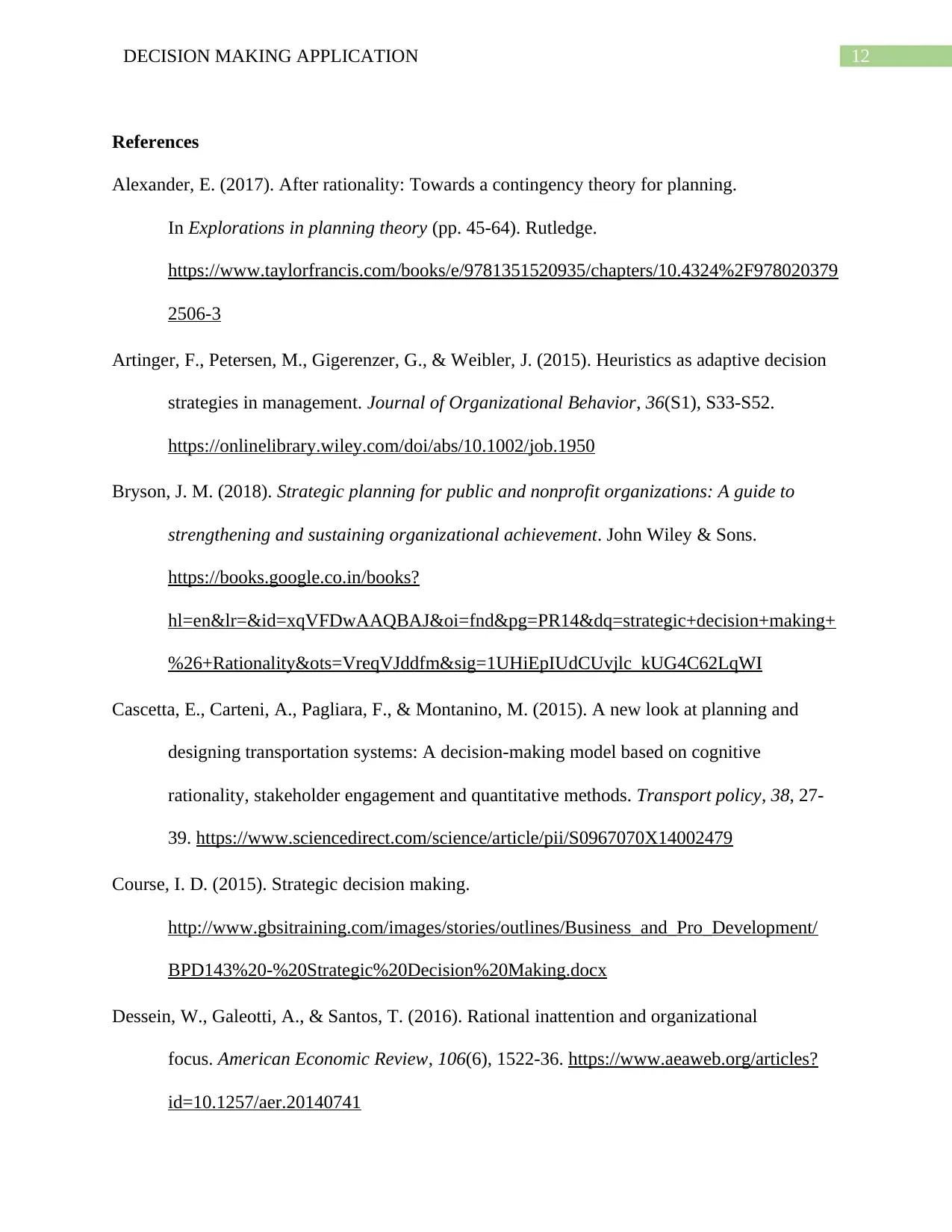
12DECISION MAKING APPLICATION
References
Alexander, E. (2017). After rationality: Towards a contingency theory for planning.
In Explorations in planning theory (pp. 45-64). Rutledge.
https://www.taylorfrancis.com/books/e/9781351520935/chapters/10.4324%2F978020379
2506-3
Artinger, F., Petersen, M., Gigerenzer, G., & Weibler, J. (2015). Heuristics as adaptive decision
strategies in management. Journal of Organizational Behavior, 36(S1), S33-S52.
https://onlinelibrary.wiley.com/doi/abs/10.1002/job.1950
Bryson, J. M. (2018). Strategic planning for public and nonprofit organizations: A guide to
strengthening and sustaining organizational achievement. John Wiley & Sons.
https://books.google.co.in/books?
hl=en&lr=&id=xqVFDwAAQBAJ&oi=fnd&pg=PR14&dq=strategic+decision+making+
%26+Rationality&ots=VreqVJddfm&sig=1UHiEpIUdCUvjlc_kUG4C62LqWI
Cascetta, E., Carteni, A., Pagliara, F., & Montanino, M. (2015). A new look at planning and
designing transportation systems: A decision-making model based on cognitive
rationality, stakeholder engagement and quantitative methods. Transport policy, 38, 27-
39. https://www.sciencedirect.com/science/article/pii/S0967070X14002479
Course, I. D. (2015). Strategic decision making.
http://www.gbsitraining.com/images/stories/outlines/Business_and_Pro_Development/
BPD143%20-%20Strategic%20Decision%20Making.docx
Dessein, W., Galeotti, A., & Santos, T. (2016). Rational inattention and organizational
focus. American Economic Review, 106(6), 1522-36. https://www.aeaweb.org/articles?
id=10.1257/aer.20140741
References
Alexander, E. (2017). After rationality: Towards a contingency theory for planning.
In Explorations in planning theory (pp. 45-64). Rutledge.
https://www.taylorfrancis.com/books/e/9781351520935/chapters/10.4324%2F978020379
2506-3
Artinger, F., Petersen, M., Gigerenzer, G., & Weibler, J. (2015). Heuristics as adaptive decision
strategies in management. Journal of Organizational Behavior, 36(S1), S33-S52.
https://onlinelibrary.wiley.com/doi/abs/10.1002/job.1950
Bryson, J. M. (2018). Strategic planning for public and nonprofit organizations: A guide to
strengthening and sustaining organizational achievement. John Wiley & Sons.
https://books.google.co.in/books?
hl=en&lr=&id=xqVFDwAAQBAJ&oi=fnd&pg=PR14&dq=strategic+decision+making+
%26+Rationality&ots=VreqVJddfm&sig=1UHiEpIUdCUvjlc_kUG4C62LqWI
Cascetta, E., Carteni, A., Pagliara, F., & Montanino, M. (2015). A new look at planning and
designing transportation systems: A decision-making model based on cognitive
rationality, stakeholder engagement and quantitative methods. Transport policy, 38, 27-
39. https://www.sciencedirect.com/science/article/pii/S0967070X14002479
Course, I. D. (2015). Strategic decision making.
http://www.gbsitraining.com/images/stories/outlines/Business_and_Pro_Development/
BPD143%20-%20Strategic%20Decision%20Making.docx
Dessein, W., Galeotti, A., & Santos, T. (2016). Rational inattention and organizational
focus. American Economic Review, 106(6), 1522-36. https://www.aeaweb.org/articles?
id=10.1257/aer.20140741
Paraphrase This Document
Need a fresh take? Get an instant paraphrase of this document with our AI Paraphraser
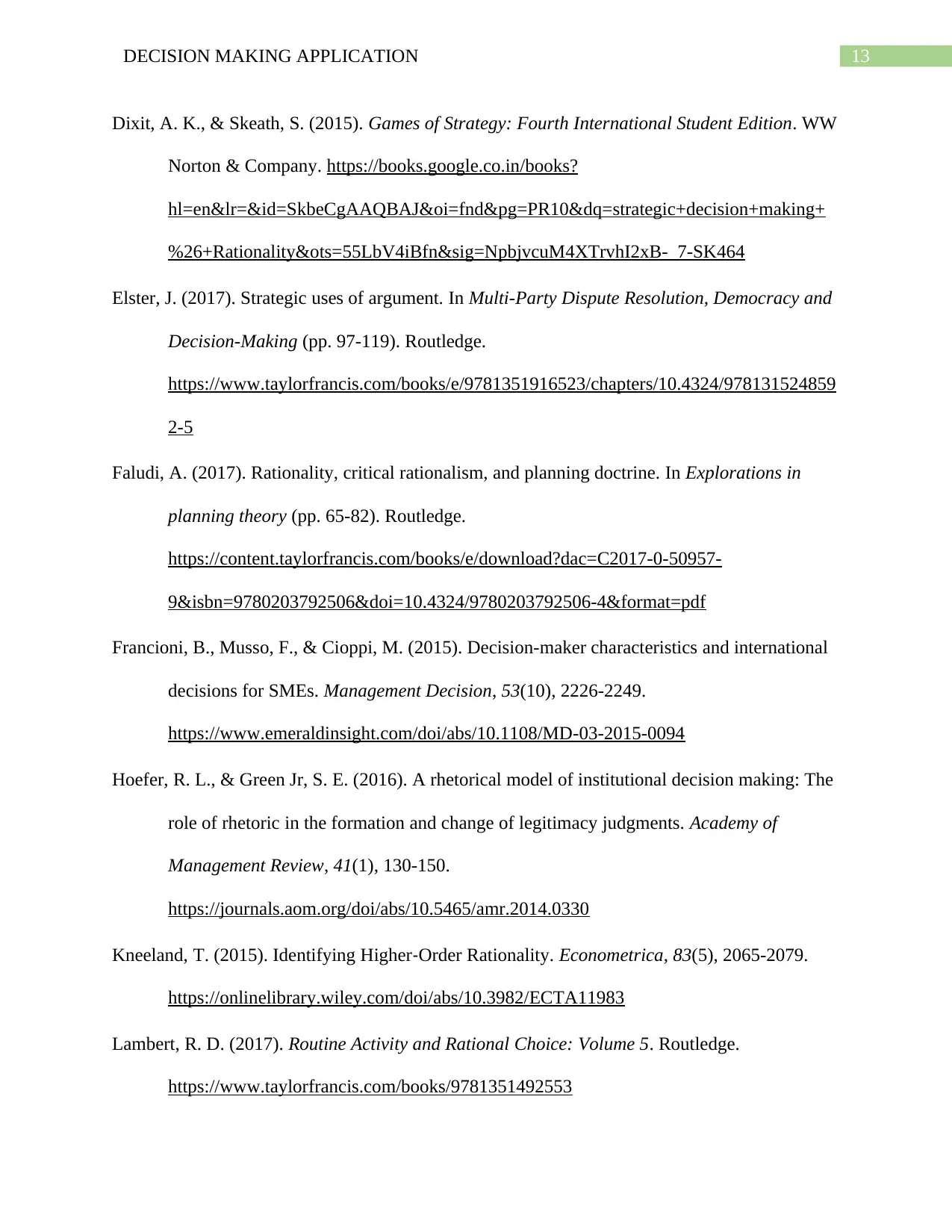
13DECISION MAKING APPLICATION
Dixit, A. K., & Skeath, S. (2015). Games of Strategy: Fourth International Student Edition. WW
Norton & Company. https://books.google.co.in/books?
hl=en&lr=&id=SkbeCgAAQBAJ&oi=fnd&pg=PR10&dq=strategic+decision+making+
%26+Rationality&ots=55LbV4iBfn&sig=NpbjvcuM4XTrvhI2xB-_7-SK464
Elster, J. (2017). Strategic uses of argument. In Multi-Party Dispute Resolution, Democracy and
Decision-Making (pp. 97-119). Routledge.
https://www.taylorfrancis.com/books/e/9781351916523/chapters/10.4324/978131524859
2-5
Faludi, A. (2017). Rationality, critical rationalism, and planning doctrine. In Explorations in
planning theory (pp. 65-82). Routledge.
https://content.taylorfrancis.com/books/e/download?dac=C2017-0-50957-
9&isbn=9780203792506&doi=10.4324/9780203792506-4&format=pdf
Francioni, B., Musso, F., & Cioppi, M. (2015). Decision-maker characteristics and international
decisions for SMEs. Management Decision, 53(10), 2226-2249.
https://www.emeraldinsight.com/doi/abs/10.1108/MD-03-2015-0094
Hoefer, R. L., & Green Jr, S. E. (2016). A rhetorical model of institutional decision making: The
role of rhetoric in the formation and change of legitimacy judgments. Academy of
Management Review, 41(1), 130-150.
https://journals.aom.org/doi/abs/10.5465/amr.2014.0330
Kneeland, T. (2015). Identifying Higher‐Order Rationality. Econometrica, 83(5), 2065-2079.
https://onlinelibrary.wiley.com/doi/abs/10.3982/ECTA11983
Lambert, R. D. (2017). Routine Activity and Rational Choice: Volume 5. Routledge.
https://www.taylorfrancis.com/books/9781351492553
Dixit, A. K., & Skeath, S. (2015). Games of Strategy: Fourth International Student Edition. WW
Norton & Company. https://books.google.co.in/books?
hl=en&lr=&id=SkbeCgAAQBAJ&oi=fnd&pg=PR10&dq=strategic+decision+making+
%26+Rationality&ots=55LbV4iBfn&sig=NpbjvcuM4XTrvhI2xB-_7-SK464
Elster, J. (2017). Strategic uses of argument. In Multi-Party Dispute Resolution, Democracy and
Decision-Making (pp. 97-119). Routledge.
https://www.taylorfrancis.com/books/e/9781351916523/chapters/10.4324/978131524859
2-5
Faludi, A. (2017). Rationality, critical rationalism, and planning doctrine. In Explorations in
planning theory (pp. 65-82). Routledge.
https://content.taylorfrancis.com/books/e/download?dac=C2017-0-50957-
9&isbn=9780203792506&doi=10.4324/9780203792506-4&format=pdf
Francioni, B., Musso, F., & Cioppi, M. (2015). Decision-maker characteristics and international
decisions for SMEs. Management Decision, 53(10), 2226-2249.
https://www.emeraldinsight.com/doi/abs/10.1108/MD-03-2015-0094
Hoefer, R. L., & Green Jr, S. E. (2016). A rhetorical model of institutional decision making: The
role of rhetoric in the formation and change of legitimacy judgments. Academy of
Management Review, 41(1), 130-150.
https://journals.aom.org/doi/abs/10.5465/amr.2014.0330
Kneeland, T. (2015). Identifying Higher‐Order Rationality. Econometrica, 83(5), 2065-2079.
https://onlinelibrary.wiley.com/doi/abs/10.3982/ECTA11983
Lambert, R. D. (2017). Routine Activity and Rational Choice: Volume 5. Routledge.
https://www.taylorfrancis.com/books/9781351492553
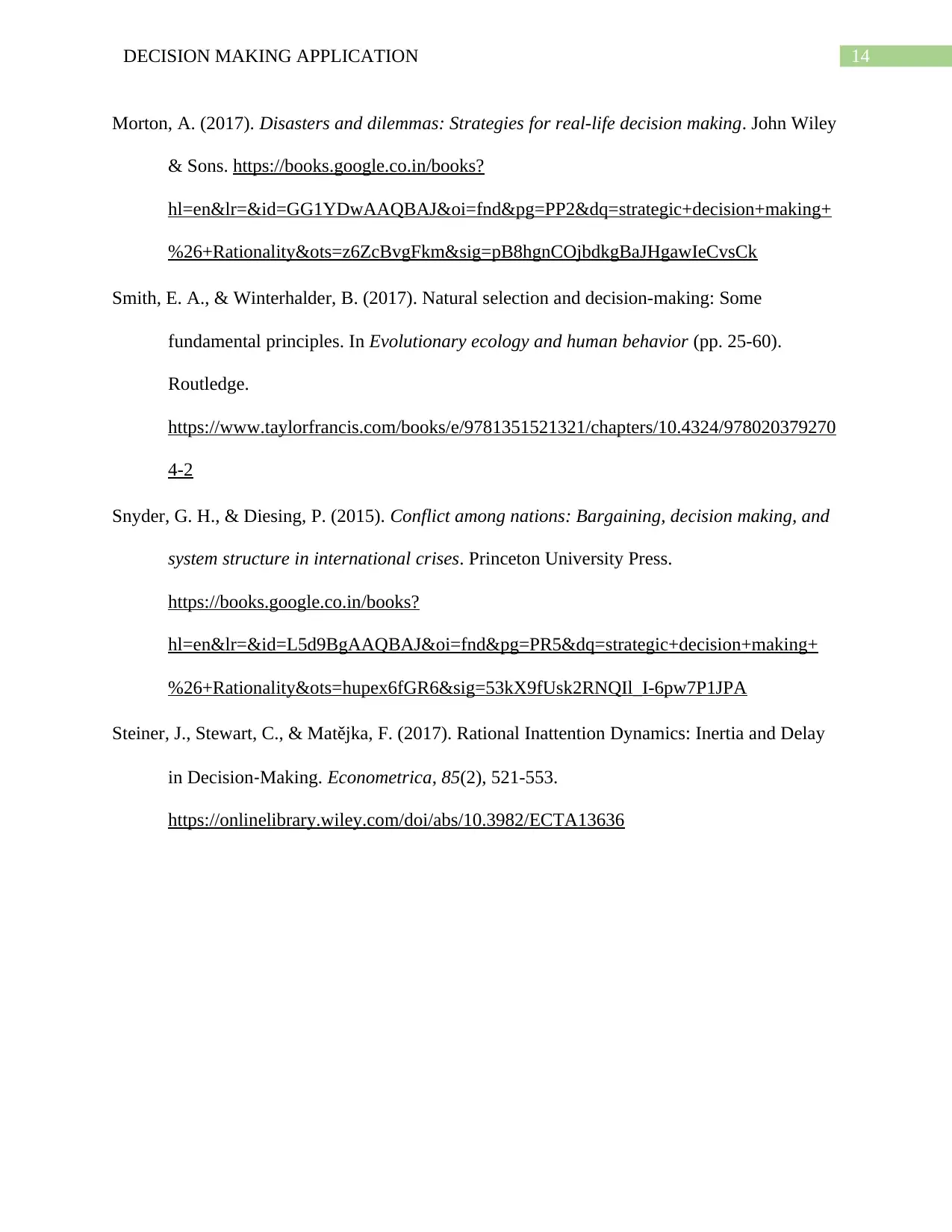
14DECISION MAKING APPLICATION
Morton, A. (2017). Disasters and dilemmas: Strategies for real-life decision making. John Wiley
& Sons. https://books.google.co.in/books?
hl=en&lr=&id=GG1YDwAAQBAJ&oi=fnd&pg=PP2&dq=strategic+decision+making+
%26+Rationality&ots=z6ZcBvgFkm&sig=pB8hgnCOjbdkgBaJHgawIeCvsCk
Smith, E. A., & Winterhalder, B. (2017). Natural selection and decision-making: Some
fundamental principles. In Evolutionary ecology and human behavior (pp. 25-60).
Routledge.
https://www.taylorfrancis.com/books/e/9781351521321/chapters/10.4324/978020379270
4-2
Snyder, G. H., & Diesing, P. (2015). Conflict among nations: Bargaining, decision making, and
system structure in international crises. Princeton University Press.
https://books.google.co.in/books?
hl=en&lr=&id=L5d9BgAAQBAJ&oi=fnd&pg=PR5&dq=strategic+decision+making+
%26+Rationality&ots=hupex6fGR6&sig=53kX9fUsk2RNQIl_I-6pw7P1JPA
Steiner, J., Stewart, C., & Matějka, F. (2017). Rational Inattention Dynamics: Inertia and Delay
in Decision‐Making. Econometrica, 85(2), 521-553.
https://onlinelibrary.wiley.com/doi/abs/10.3982/ECTA13636
Morton, A. (2017). Disasters and dilemmas: Strategies for real-life decision making. John Wiley
& Sons. https://books.google.co.in/books?
hl=en&lr=&id=GG1YDwAAQBAJ&oi=fnd&pg=PP2&dq=strategic+decision+making+
%26+Rationality&ots=z6ZcBvgFkm&sig=pB8hgnCOjbdkgBaJHgawIeCvsCk
Smith, E. A., & Winterhalder, B. (2017). Natural selection and decision-making: Some
fundamental principles. In Evolutionary ecology and human behavior (pp. 25-60).
Routledge.
https://www.taylorfrancis.com/books/e/9781351521321/chapters/10.4324/978020379270
4-2
Snyder, G. H., & Diesing, P. (2015). Conflict among nations: Bargaining, decision making, and
system structure in international crises. Princeton University Press.
https://books.google.co.in/books?
hl=en&lr=&id=L5d9BgAAQBAJ&oi=fnd&pg=PR5&dq=strategic+decision+making+
%26+Rationality&ots=hupex6fGR6&sig=53kX9fUsk2RNQIl_I-6pw7P1JPA
Steiner, J., Stewart, C., & Matějka, F. (2017). Rational Inattention Dynamics: Inertia and Delay
in Decision‐Making. Econometrica, 85(2), 521-553.
https://onlinelibrary.wiley.com/doi/abs/10.3982/ECTA13636
1 out of 15
Related Documents
Your All-in-One AI-Powered Toolkit for Academic Success.
+13062052269
info@desklib.com
Available 24*7 on WhatsApp / Email
![[object Object]](/_next/static/media/star-bottom.7253800d.svg)
Unlock your academic potential
© 2024 | Zucol Services PVT LTD | All rights reserved.





